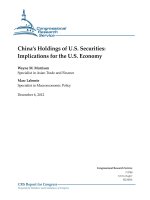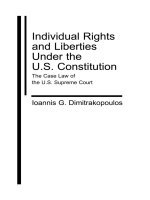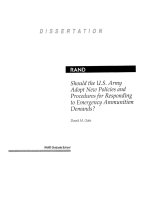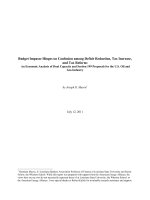seepage analysis and control for dams - u.s. army corps of engineers - part a
Bạn đang xem bản rút gọn của tài liệu. Xem và tải ngay bản đầy đủ của tài liệu tại đây (2.78 MB, 201 trang )
CECW-EG
Engineer Manual
1110-2-1901
Department of the Army
U.S. Army Corps of Engineers
Washington, DC 20314-1000
EM 1110-2-1901
30 September 1986
(original)
30 April 1993
(change 1)
Engineering and Design
SEEPAGE ANALYSIS AND
CONTROL FOR DAMS
Distribution Restriction Statement
Approved for public release;
distribution is unlimited.
CECW-EG-S
Engineer Manual
No. 111 O-2-1 901
DEPARTMENT OF THE ARMY
U.S. Army Corps of Engineers
Washington, DC 20314-1000
EM 1110-2-l 901
Change 1
30 April 1993
Engineering and Design
SEEPAGE ANALYSIS AND CONTROL FOR DAMS
1. This change replaces Appendix D, “Filter and Drain Design and Construction” of EM 1110-2-1901,
dated 30 September 1986.
2. File this change sheet in front of the publication for reference purposes.
FOR THE COMMANDER:
WILLIAM D. BROWN
Colonel, Corps of Engineers
Chief of Staff
ENGINEER MANUAL
EM 1110-2-1901
30 September 1986
ENGINEERING AND DESIGN
SEEPAGE ANALYSIS AND
CONTROL FOR DAMS
DEPARTMENT OF THE ARMY
CORPS OF ENGINEERS
OFFICE OF THE CHIEF OF ENGINEERS
DAEN-ECE-G
Engineer Manual
No. 1110-2-1901
30 September 1986
Engineering and Design
SEEPAGE ANALYSIS AND CONTROL FOR DAMS
1.
Purpose.
This manual presents the fundamental design principles and
guidance concerning seepage considerations for design of new dams and the
evaluation of existing projects.
2.
Applicability.
This manual is applicable to all HQUSACE/OCE elements and
field operating activities having responsibility for the design and
construction of civil works projects.
3.
Discussion.
All earth and rock-fill dams are subject to seepage through
the embankment, foundation, and abutments.
Concrete gravity and arch dams are
subject to seepage through the foundation and abutments.
Seepage control is
necessary to prevent excessive uplift pressures, sloughing of the downstream
slope, piping through the embankment and foundation, and erosion of material
by loss into open joints in the foundation and abutments. The purpose of the
project, i.e.,
long-term storage, flood control, etc.,
may impose limitations
on the allowable quantity of seepage.
FOR THE COMMANDER:
Chief of Staff
This manual supersedes EM 1110-2-1901 dated February 1952
DEPARTMENT OF THE ARMY
US Army Corps of Engineers
Washington, D. C. 20314-1000
EM-1110-2-1901
30 September 1986
DAEN-ECE-G
Engineer Manual
No. 1110-2-1901
Engineering and Design
SEEPAGE ANALYSIS AND CONTROL FOR DAMS
Table of Contents
Page
ParagraphSubject
CHAPTER 1. INTRODUCTION
Purpose
Applicability
References
Objective and Scope
General Considerations
1-1
1-2
1-3
1-4
1-5
1-1
1-1
1-1
1-1
1-1
CHAPTER 2. DETERMINATION OF PERMEABILITY OF SOIL
AND CHEMICAL COMPOSITION OF WATER
Darcy's Law
Range of Validity of Darcy's Law
Coefficient of Permeability
Factors Influencing Permeability
Indirect Methods for Determining
Permeability
Laboratory Methods for Determining
Permeability
Origin,
Occurrence, and Movement of
Ground Water
Field Methods for Determining
permeability
Chemical Composition of Ground Water and
River (or Reservoir) Water
2-1
2-1
2-2
2-4
2-3 2-6
2-4
2-9
2-5
2-20
2-6
2-28
2-7
2-30
2-8
2-33
2-9
2-34
CHAPTER 3. DETERMINATION OF PERMEABILITY OF ROCK
Permeabilities of Rock Masses
Flow Characteristics in Rock Masses
Methods for Determining Rock Mass
Permeability
Applications of Rock Mass Permeability
3-1
3-1
3-2
3-1
3-3
3-4
3-3
3-11
This manual supersedes EM 1110-2-1901, Feb 52
i
EM 1110-2-1901
30 Sep 86
Subject
Paragraph
Page
CHAPTER 4.
SEEPAGE PRINCIPLES
General Considerations
Boundary Conditions
Confined and Unconfined Flow Problems
Laplace’s Equation
Methods for Solution of Laplace's
Equation
Graphical Method for Flow Net
Construction
Flow Net for Anisotropic Soil
Flow Net for Composite Sections
Determination of Seepage Quantities,
Escape Gradients, Seepage Forces, and
Uplift Pressures
4-1 4-1
4-2 4-1
4-3 4-2
4-4 4-3
4-5
4-6
4-7
4-8
4-5
4-9
4-14
4-14
4-9
4-21
CHAPTER 5.
CONFINED FLOW PROBLEMS
General Considerations
Gravity Dam on Pervious Foundation of
Finite Depth
Gravity Dams on Infinitely Deep
Pervious Foundations
5-1
5-1
5-2
5-1
5-3
5-1
CHAPTER 6.
UNCONFINED FLOW PROBLEMS
Introduction
Homogeneous Earth Dam on Impervious
Foundation
Earth Dam with Horizontal Drain on
Impervious Foundation
Earth Dam with Toe Drain on Impervious
Foundation
Earth Dam with Vertical or near Vertical
Horizontal Drains on Impervious
Foundation
Flow Net for a Composite Zoned Dam
Zoned Earth Dam on Pervious Foundation
6-1
6-1
6-2
6-1
6-3 6-10
6-4
6-10
6-5
6-10
6-6
6-10
6-7
6-17
CHAPTER 7.
SEEPAGE TOWARD WELLS
Use of Wells
Analysis of Well Problems
Basic Well Equations for Steady State
Flow
Special Conditions
Nonsteady State Flow
7-1 7-1
7-2
7-1
7-3
7-2
7-4
7-11
7-5
7-21
ii
EM 1110-2-1901
30 Sep 86
Subject
Paragraph
Page
CHAPTER 8.
SEEPAGE CONTROL IN EMBANKMENTS
CHAPTER 9.
SEEPAGE CONTROL IN EARTH FOUNDATIONS
CHAPTER 10.
CHAPTER 11.
CHAPTER 12.
REMEDIAL SEEPAGE CONTROL
General
Methods for Seepage Control
Flat Slopes Without Drains
Zoning Embankments
Vertical (or Inclined) and Horizontal
Drains
Seepage Control Against Earthquake
8-1
8-2
8-3
8-4
8-5
8-6
8-1
8-1
8-1
8-1
Effects
8-8
8-18
General
Selection of Method for Seepage
9-1
9-2
9-3
9-4
9-5
9-6
9-7
9-8
9-9
9-1
Control
Horizontal Drains
Cutoffs
Upstream Impervious Blanket
Downstream Seepage Berms
Relief Wells
Trench Drain
Concrete Galleries
9-1
9-1
9-1
9-48
9-58
9-62
9-83
9-84
SEEPAGE CONTROL THROUGH EARTH ABUTMENTS
ADJACENT TO STRUCTURES AND BENEATH
SPILLWAYS AND STILLING BASINS
Through Earth Abutments
Adjacent to Outlet Conduits
Beneath Spillways and Stilling Basins
10-1
10-2
10-3
10-1
10-1
10-3
SEEPAGE CONTROL IN ROCK FOUNDATIONS AND
ABUTMENTS
General Considerations
Cutoff Trenches
Abutment Impervious Blankets
Drainage and Grouting Galleries and
Tunnels
Grouting of Foundations and Abutments
Surface Treatment of Foundations and
Abutments
11-1
11-2
11-3
11-1
11-1
11-2
11-4
11-5
11-2
11-3
11-6
11-3
General Considerations
12-1 12-1
Remedial Methods
12-2
12-1
Storage Restriction
12-3
12-2
Grouting
12-4
12-2
iii
EM 1110-2-1901
30 Sep 86
Subject
CHAPTER 13.
CHAPTER 14.
APPENDIX A.
APPENDIX B.
APPENDIX C.
Upstream Impervious Blanket
12-5
Downstream Berm
12-6
Slurry Trench Cutoff
12-7
Relief Wells
12-8
Drainage of Downstream Slope
12-9
Page
12-4
12-6
12-6
12-11
12-12
MONITORING PERFORMANCE OF SEEPAGE CONTROL
MEASURES
General Considerations
13-1 13-1
Piezometers for Seepage Pressures
13-2 13-1
Flow Measurements
13-3
13-12
Seepage Water Analysis
13-4 13-18
Remote Sensing Methods
13-5
13-20
INSPECTION, MAINTENANCE, AND REHABILITA-
TION OF SEEPAGE CONTROL MEASURES
Introduction
14-1 14-1
Inspection
14-2
14-1
Maintenance
14-3
14-1
Rehabilitation
14-4 14-3
REFERENCES
Government Publications
Non-Government Publications
APPROXIMATE METHODS FOR ANALYSIS OF FLOW
PROBLEMS
A-1
A-11
Introduction
Electrical Analogy
Sand Tank Model
Viscous Flow Models
Method of Fragments
Finite Difference Method
Finite Element Method
B-1 B-1
B-2
B-1
B-3
B-2
B-4
B-5
B-5
B-5
B-6
B-28
B-7 B-29
ANALYSIS OF PRESSURE INJECTION TESTS
(Ziegler 1976)
Water pressure Tests
Air pressure Tests
pressure Holding Testy
C-1
C-2
C-3
C-1
C-11
C-17
Paragraph
iv
EM 1110-2-1901
30 Sep 86
Subject
Paragraph
Page
APPENDIX D.
FILTER AND DRAIN DESIGN AND CONSTRUCTION
General
Stability
Permeability
Applicability
Perforated Pipe
Gap-Graded Base
Gap-Graded Filter
Broadly-Graded Base
Graded Filter Design
Geotextiles
Construction
Monitoring
D-1
D-2
D-3
D-4
D-5
D-6
D-7
D-8
D-9
D-10
D-11
D-12
D-1
D-1
D-2
D-2
D-3
D-3
D-5
D-5
D-5
D-6
D-6
D-8
v
EM 1110-2-1901
30 Sep 86
CHAPTER 1
INTRODUCTION
1-1.
Purpose.
This manual provides guidance and information concerning seep-
age analysis and control for dams.
1-2.
Applicability.
The provisions of this manual are applicable to all
HQUSACE/OCE elements and field operating activities (FOA) having responsibil-
ity for seepage analysis and control for dams.
1-3 References. Appendix A contains a list of Government and non-Government
references pertaining to this manual.
Each reference is identified in the
text by either the designated publication number or by author and date.
Reference to cited material in tables and figures is identified throughout the
manual by superscripted numbers (item 1, 2, etc.) that correspond to similarly
numbered items in Appendix A.
1-4.
Objective and Scope.
The objective of this manual is to provide a guide
for seepage analysis and control for dams.
1-5.
General Considerations.
All earth and rock-fill dams are subject to
seepage through the embankment, foundation, and abutments.
Concrete gravity
and arch dams are subject to seepage through the foundation and abutments.
Seepage control is necessary to prevent excessive uplift pressures, sloughing
of the downstream slope, piping through the embankment and foundation, and
erosion of material by loss into open joints in the foundation and abutments.
The purpose of the project, i.e., long-term storage, flood control, etc., may
impose limitations on the allowable quantity of seepage (Sowers 1977).
1-1
EM 1110-2-1901
30 Sep 86
CHAPTER 2
DETERMINATION OF PERMEABILITY OF SOIL AND
CHEMICAL COMPOSITION OF WATER
2-1.
Darcy's Law.
a.
Development of Darcy's Law. Henry Darcy, a French engineer, con-
ducted a laboratory experiment to study the flow of water in verticals and
filters which he published in his 1856 treatise. The results of his experiment
indicated that (Rouse and Ince 1957)
v = ki
(2-1)
or since Q =
V
A
or using q =
Q = kiAt
q
= kiA
(2-2)
(2-3)
\where
v = discharge velocity
k=
(1)
Darcy's coefficient of permeability
i
= hydraulic gradient (head loss/length over which head loss occurs)
Q = quantity of discharge
A=
cross-sectional area of flow
t
= time of flow
q
= rate of discharge
b.
Extension to Inclined Soil Column.
Darcy's law may be extended to
flow through an inclined soil column given in figure 2-1 (Harr 1962). As
indicated in equation 2-1, flow is a consequence of differences in total
(1)
Commonly called the coefficient of permeability or the permeability.
2-1
EM 1110-2-1901
30 Sep 86
head
(l)
and not of pressure gradients (Harr 1962 and Bear 1972). As shown in
figure 2-1, flow is directed from point A to point B even though the pressure
at point B is greater than that at point A.
Figure 2-1.
Darcy's law for flow through inclined soil column
(prepared by WES)
(1)
The elevation head at any point is the distance from some arbitrary datum.
The pressure head is the water pressure divided by the unit weight of the
water.
The total head is the sum of the elevation head and the pressure
head.
2-2
EM 1110-2-1901
30 Sep 86
c.
Discharge Velocity and Seepage Velocity.
The discharge velocity is
defined as the quantity of fluid that flows through a unit cross-sectional area
of the soil oriented at a right angle to the direction of flow in a unit time.
The discharge velocity is used in determining the quantity of flow or rate of
discharge through a soil.
As flow can occur only through the interconnected
pores of the soil, as shown in figure 2-2, the actual rate
of
Figure 2-2.
Concepts of flow paths through a soil column
(prepared by WES)
movement of the water,
as measured with dye tracers for instance, is the seep-
age velocity (Harr 1962 and Casagrande 1937) which exceeds the discharge
velocity.
2-3
(2-4)
EM 1110-2-1901
30 Sep 86
where
seepage velocity
n = porosity (ratio of volume of voids to the total volume of the soil
mass)
It follows that
Equation 2-5 is a useful expression in estimating field permeabilities using
dye tracers (Soil Conservation Service 1978).
2-2.
Range of Validity of Darcy's Law.
a.
Lower Bound. Darcy's law (equations 2-1 through 2-3) applies to
linear flow (adjacent flow lines are locally straight and parallel). For flows
through soils,
there are two situations where the validity of this linear
relationship may not hold. For highly plastic clays of low permeability, there
may be a threshold hydraulic gradient below which flow does not take place.
Such conditions may occur in deeply buried clays and clay shales.
For many
practical seepage problems the rate of flow through these soil layers is so
small that they can be considered to be impervious (Mitchell 1976, Chugaev
1971, Basak and Madhav 1979, and Muskat 1946).
b.
Upper Bound.
Of greater practical importance is the upper limit on
the range of validity of Darcy's law.
It has been recognized that, at very
high flow rates, Darcy's law does not hold (Chugaev 1971). The upper limit is
usually identified using Reynolds number, a dimensionless number that expresses
the ratio of internal to viscous forces during flow.
It is often used in fluid
mechanics to distinguish between laminar flow (fluid layer flows alongside of
another at approximately the same velocity with no macroscopic mixing of fluid
particles) at low velocities and turbulent flow (velocity fluctuations, both
parallel and transverse,
are imposed upon the mean motion with mixing of the
fluid particles) at high velocities.
The Reynolds number for flow through
soils is
(2-6)
where
Reynolds number
D=
average diameter of soil particles
2-4
EM 1110-2-1901
30 Sep 86
= density of fluid
= coefficient of dynamic viscosity of fluid
The critical value-of Reynolds number at which the flow in soils changes from
laminar to turbulent has been determined experimentally by various investiga-
tors to range from 1 to 12 (Harr 1962 and Chugaev 1971). Assuming a water
temperature of 20º C, substituting = 998.2 kg/m
3
and µ
= 1.002 x
10
-3
kg/m
sec into equation 2-6,
and assuming values of D and solving for v with
= 1 and
=
12 gives the relationship shown in figure 2-3 which defines
the upper bound of the validity of Darcy's law.
Depending on the discharge
velocity, Darcy's law is generally applicable for silts through medium sands.
c.
Turbulent Flow.
(1) Estimating Permeability from Empirical Equation. For flow through
soils more pervious than medium sands,
flow is likely to be turbulent. Under
turbulent conditions, the seepage velocity in a material with monosized soil
particles (coarse sands and/or gravels) can be estimated from the following
equation (Wilkins 1956, Leps 1973, and Stephenson 1979).
(2-7)
where
= seepage velocity in inches per second
w=
an empirical constant, which depends on the shape and roughness of
the soil particles and viscosity of water and varies from 33 for
crushed gravel to 46 for polished marbles, in inch
1/2
per second
M=
hydraulic mean radius of the rock voids (for a given volume of
particles equal to the volume of voids divided by the total surface
area of the particles,
or the void ratio divided by the surface area
per unit volume of solids) in inches
i
= hydraulic gradient
The coefficient of permeability is obtained from the seepage velocity using
equation 2-5.
For well-graded soils, the D
50
size (50 percent finer by weight)
can be used to calculate the hydraulic mean radius provided that the minus
1-in size material is less than 30 percent by weight.
If there is more than
30 percent of minus 1-in
size material, the permeability should be determined
experimentally (Leps 1973).
(2) Determining Permeability Experimentally. Alternatively, for flow
through soils more pervious than medium sands, the relationship between
hydraulic gradient and discharge velocity can be determined experimentally
(Cedergren 1977).
2-5
EM 1110-2-1901
30 Sep 86
Figure 2-3.
Boundary between laminar and turbulent flow determined
using Reynolds number for temperature of 20° C (prepared by WES)
2-3.
Coefficient of Permeability.
a. Darcy's (Engineer's) Coefficient of Permeability.
The coefficient
of permeability used in seepage analysis for dams is called the Darcy's or
engineer's coefficient and is given by (Cedergren 1977)
2-6
EM 1110-2-1901
30 Sep 86
(2-8)
or since Q =
V
A
or using q =
(2-9)
(2-10)
The coefficient of permeability is defined as the rate of discharge-of water
at a temperature of 20º C under conditions of laminar flow through a unit
cross-sectional area of a saturated soil medium.
The coefficient of perme-
ability has the dimensions of a velocity and is usually expressed in centi-
meters per second.
Permeability computed on the basis of Darcy's law is
limited to the conditions of laminar flow and complete saturation of the soil.
Under conditions of partial saturation,
the flow is in a transient state and
is time dependent.
To analyze natural flow conditions which depart from the
Darcy flow condition, it is sometimes necessary to apply Darcy's law in condi-
tions where it is not strictly valid.
When this is done, the effects of tur-
bulent flow and partial saturation on the permeability must be recognized and
taken into consideration (Cedergren 1975).
b.
Intrinsic (Specific) Permeability.
The coefficient of permeability
of a soil material varies for different pore fluids depending upon their
density and viscosity as follows:
where
= intrinsic permeability
= unit weight of pore fluid
µ
= viscosity of pore fluid
(2-11)
The intrinsic permeability has the dimensions of length squared and is
expressed in square centimeters or Darcy's (equal to 1.01 x 10
-8
cm
2
).
Fig-
ure 2-4 is a chart for the conversion of permeability values from one set of
2-7
EM 1110-2-1901
30 Sep 86
2-8
EM 1110-2-1901
30 Sep 86
units to another (Lohman et al. 1972).
Substituting equation 2-11 into
equation 2-1
(2-12)
Equation 2-12 may be used when dealing with more than one fluid or with temper-
ature variations.
This is widely used in the petroleum industry where the
presence of gas, oil,
and water occur in multiphase flow systems (Freeze and
Cherry 1979, and Bureau of Reclamation 1977). In seepage analysis for earth
dams where we are primarily interested in the flow of water subject to small
changes in temperature, this refinement is seldom required.
c.
Transmissivity Factor.
In order to describe the flow characteris-
tics of an aquifer (saturated permeable geologic unit that can transmit
significant quantities of water under ordinary hydraulic gradients),
C. V. Thesis introduced the term transmissivity which is defined as (Bureau of
Reclamation 1977)
T
= kt
(2-13)
where
T = transmissivity factor
k = average permeability
t = aquifer thickness
Transmissivity represents the rate of discharge for a gradient of unity
through a vertical strip of aquifer one unit wide and has dimensions of length
squared per unit time and is usually expressed in square feet per day.
2-4.
Factors Influencing Permeability.
a.
Range of Values of Permeability.
No other property of soil exhibits
a wider range of values (up to ten orders of magnitude) or shows greater
directional (anisotropy) and spatial variability in a given deposit as does
the coefficient of permeability.
The approximate range in coefficients of
permeability for soils and rocks is shown in figure 2-5 (Milligan 1976).
Within the range,
extreme variations of permeability in situ are possible due
to the degree of stratification or heterogeneity of the soil deposit.
b.
Variation of In Situ Permeability.
Natural soil deposits are
generally stratified in structure.
Water-deposited soils are laid down in
'horizontal layers and are often more permeable in the horizontal than vertical
direction.
Windblown sands and silts are generally more permeable vertically
than horizontally due to the presence of continuous vertical root holes. An
important example of stratification is openwork gravel which may occur in
2-9
EM 1110-2-1901
30 Sep 86
Figure 2-5. Approximate range in coefficient of
permeability of soils and rocks (from Milligan
224
)
ordinary gravel or soil and have tremendous influence on the watertightness of
dam foundations and abutments as shown in figure 2-6 (Cedergren 1977). Fig-
ure 2-6a shows a soil profile surmised from several drill holes.
The grain
size analysis of soil samples taken at frequent intervals erroneously indicated
that the deposit was composed of relatively uniform sandy gravels.
Laboratory
permeability tests on disturbed samples produced coefficients of permeability
of about 1 x
10
-6
cm/sec.
Using this value of permeability, the probable
seepage loss beneath the proposed dam was estimated to be 3 cu ft/day, which is
an insignificant quantity. However, the design engineer had observed many
openwork streaks in which the fines fraction of the material was almost
completely absent along the banks of the river and noted that the ground-water
table was level for several hundred feet away from the river and fluctuated
rapidly with changes in river stage. Field pumping tests were conducted which
indicated somewhat variable permeabilities but none approaching the magnitude
of openwork gravels.
Based upon the available data, the dam was designed with
a cutoff trench to bedrock. During the excavation of the cutoff trench,
streaks of openwork gravel were found throughout the foundation.
A revised
seepage computation based on a permeability of 30 cm/sec indicated that without
the cutoff trench,
the theoretical underseepage would be about 1,000,000 cu
ft/day.
If openwork gravel or other important discontinuities in earth dam
foundations remain undetected, serious problems from excessive seepage and
hydrostatic pressures will develop.
This example illustrates the potential
serious effects of deviations between the design assumptions and the as-built
dam (Cedergren 1977).
Also, thin continuous seams of cohesive soil can
drastically alter the vertical flow through what would otherwise be a highly
permeable site.
2-10
EM 1110-2-1901
30 Sep 86
a.
Soil profile surmised from
drill holes with estimated
quantity of seepage under
dam equal to 3 cu ft/day
b.
Soil profile revealed by
cutoff trench with esti-
mated quantity of seep-
age under dam equal to
1,000,000 cu ft/day
(without cutoff trench)
Figure 2-6.
Influence of openwork gravel on underseepage
(courtesy of John Wiley & Sons, Inc.
155)
c.
Properties of the Seepage Fluid.
The
fluid which influence the permeability of soils
viscosity,
and chemical composition.
(1) As shown in table 2-1, for the range
properties of the seepage
are the temperature, density,
of temperatures ordinarily
encountered in seepage analysis of dams (0º
C to 40º C) the density of water
is nearly constant (varies less than 1 percent).
Table 2-1.
Properties of Water
a
Temperature
°C
ºF
Density
Viscosity
kg/m
3
kg/m sec
0
32
999.8
1.787
5
41
999.9
1.519
10
50
999.7
1.307
15
59
999.1
1.139
20
68
998.2
1.002
25
77
997.0
0.890
30
86
995.6
0.798
35 95
994.0
0.719
40
104
992.2 0.653
x 10
-3
a
Prepared by WES.
2-11
EM 1110-2-1901
30 Sep 86
(2) The viscosity varies up to 63.5 percent over the range of tempera-
tures ordinarily encountered in seepage analysis of dams. As indicated in
equation 2-11,
the permeability is inversely proportional to the viscosity of
the water.
As given in table 2-1,
the viscosity of water decreases as tempera-
ture increases.
Therefore, the coefficient of permeability of the soil
increases as the temperature of the water increases.
Permeability tests are
run at the most convenient temperature and reported at 20º C.
(3) The total dissolved salts (TDS) present in the seepage water may
influence the permeability of the soil, particularly for cohesive soils (Quirk
and Schofield 1955 and Cary,
Walter, and Harstad 1943). Available data indi-
cate that cohesive soils may be two to three orders of magnitude more permeable
to seepage water containing moderate amounts of dissolved salts (less than
300 parts per million by weight) than the distilled water (Carry, Walter, and
Harstad 1943).
d.
Degree of Saturation.
The degree of saturation of a soil
where
S = degree of saturation
(2-14)
= volume of water
V
v
= volume of voids
has an important influence on permeability.
A decrease in the degree of
saturation causes a decrease in the permeability as shown in figure 2-7 (Lambe
1951).
When the degree of saturation is less than 85 percent, much of the air
would be continuous throughout the soil voids and Darcy's law would not hold.
When the degree of saturation is greater than 85 percent, most of air present
in the soil is in the form of small occluded bubbles and Darcy's law will be
approximately valid. The ratio of the permeability of the unsaturated sand to
the saturated sand at the same void ratio is given as (Scott 1963 and Parker
and Thornton 1976)
where
k
us
= unsaturated permeability
m = constant with values between 2 (uniform grain size) and
4 (well-graded materials)
(2-15)
2-12
EM 1110-2-1901
30 Sep 86
Figure 2-7.
Permeability versus degree of saturation for
various sands (courtesy of John Wiley & Sons, Inc.
200
)
e.
Hydraulic Gradient.
The hydraulic gradient
(2-16)
where
H = head loss
L = length over which head loss occurs
2-13
EM 1110-2-1901
30 Sep 86
at which permeability is measured can have a significant influence on the
coefficient of permeability computed from Darcy's law under certain condi-
tions.
The maximum hydraulic gradient for which laminar flow occurs for a
particular soil at a given density may be determined in the laboratory by
plotting the discharge velocity
(2-17)
versus the hydraulic gradient as shown in figure 2-8. A straight line
relationship indicates laminar flow
(2-18)
while deviations from the straight line at high gradients indicate turbulent
flow.
Darcy's law for a fine sand, as shown in figure 2-8, is valid only for
the hydraulic gradient less than 2 for the loose state and 4.5 for the dense
state.
For soils larger than a fine sand, Darcy's law is valid for progres-
sively smaller hydraulic gradients (Burmister 1948 and Burmister 1955).
f.
Particle Size.
For cohesive soils, the permeability increases with
increases in clay mineral size and increase in void ratio (ratio of the volume
of voids to the volume of solid particles in the soil mass) as shown in
figure 2-9 (Yong and Warkentin 1966).
(l)
For cohesionless soils, the size and
shape of the soil particles influence the permeability. Allan Hazan conducted
tests on filter sands for use in waterworks and found that for uniform loose
clean sands the permeability was given by (Taylor 1948)
(2-19)
where
k-
coefficient of permeability in cm per second
D
10
= particle size in cm at which 10 percent of the material is finer
by weight (also known as Hazen's effective size)
(1)
As shown in table 2-2, the exchangeable cation present influences the
permeability of clay minerals at constant void ratio (Scott 1963). The
permeabilities are much smaller when the exchangeable cation is sodium
which is one of the reasons why sodium montmorillonite is used to seal
reservoirs.
2-14
EM 1110-2-1901
30 Sep 86
Figure 2-8.
Determination of maximum hydraulic gradient for
which laminar flow occurs for a fine sand (courtesy of
American Society for Testing and Materials
147
)
Hazen's experiments were made on sands for which 0.1 mm < D
10
< 0.3 mm and the
uniformity coefficient,
C
u
< 5 , where
where
C
u
= uniformity coefficient
D
60
= particle size at which 60 percent of the material is finer by
weight
(2-20)
The coefficient 100 is an average of many values which ranged from 41 to 146,
but most of the values were from 81 to 117.
Equation 2-19 makes no allowance
for variations in shape of the soil particles or void ratio.
2-15









